“Nararanasan mo ba na paulit-ulit na nauubusan ng stock o sobra-sobra na ang stock ng mga produkto?” Managing inventory across multiple branches in the Philippines is no easy task. If you’re struggling with stock inconsistencies or delayed deliveries, it could affect your entire operation.
In an average restaurant, as much as 10% of food goes to waste before reaching a plate. This waste translates into unrecoverable costs for the business. Factors such as oversized portions, overly complicated menus, and staff behaviours contribute to this issue. Thankfully, these inefficiencies can be identified and minimized by implementing effective inventory management practices.
The good news is there’s a way to address these issues: central kitchen software. By consolidating inventory, production, and distribution into a unified system, you can streamline operations, reduce waste, and maintain consistent quality across all branches.
Many businesses have already adopted central kitchen systems and are seeing improvements in their operational efficiency and profitability. Are you curious how this solution can benefit your business? Keep reading to explore the best options available!
Table of Contents
Key Takeaways
|
Best Central Kitchen Software in the Philippines Shortlist
- HashMicro – Best overall for comprehensive integration with accounting, inventory, and kitchen display systems. It offers seamless POS integration for smoother operations.
- Xenia – Best for multi-unit restaurant chains, offering robust task management and compliance tools.
- Apicbase – Best for detailed recipe management, production planning, and inventory monitoring for multi-site operations.
- Gofrugal – Best for franchise and multi-outlet management, with strong production planning and waste reduction features.
- Supy – Best for streamlining internal ordering and supply chain operations between branches and the central kitchen.
- Melba – Best for catering and large-scale food production, focusing on waste reduction and optimized resource utilization.
- RestroWorks – Best for real-time kitchen operations management, ensuring efficient goods transfer and cost control.
- LS Retail – Best for real-time order management with an advanced kitchen display system (KDS) for restaurant operations.
- Galley – Best for data-driven kitchen management, offering an advanced recipe engine and real-time inventory tracking.
- LINGA ROS – Best for cloud-based management with strong POS integration and restaurant POS benefits for streamlined kitchen and order management.
1. Hashmicro Central Kitchen Software
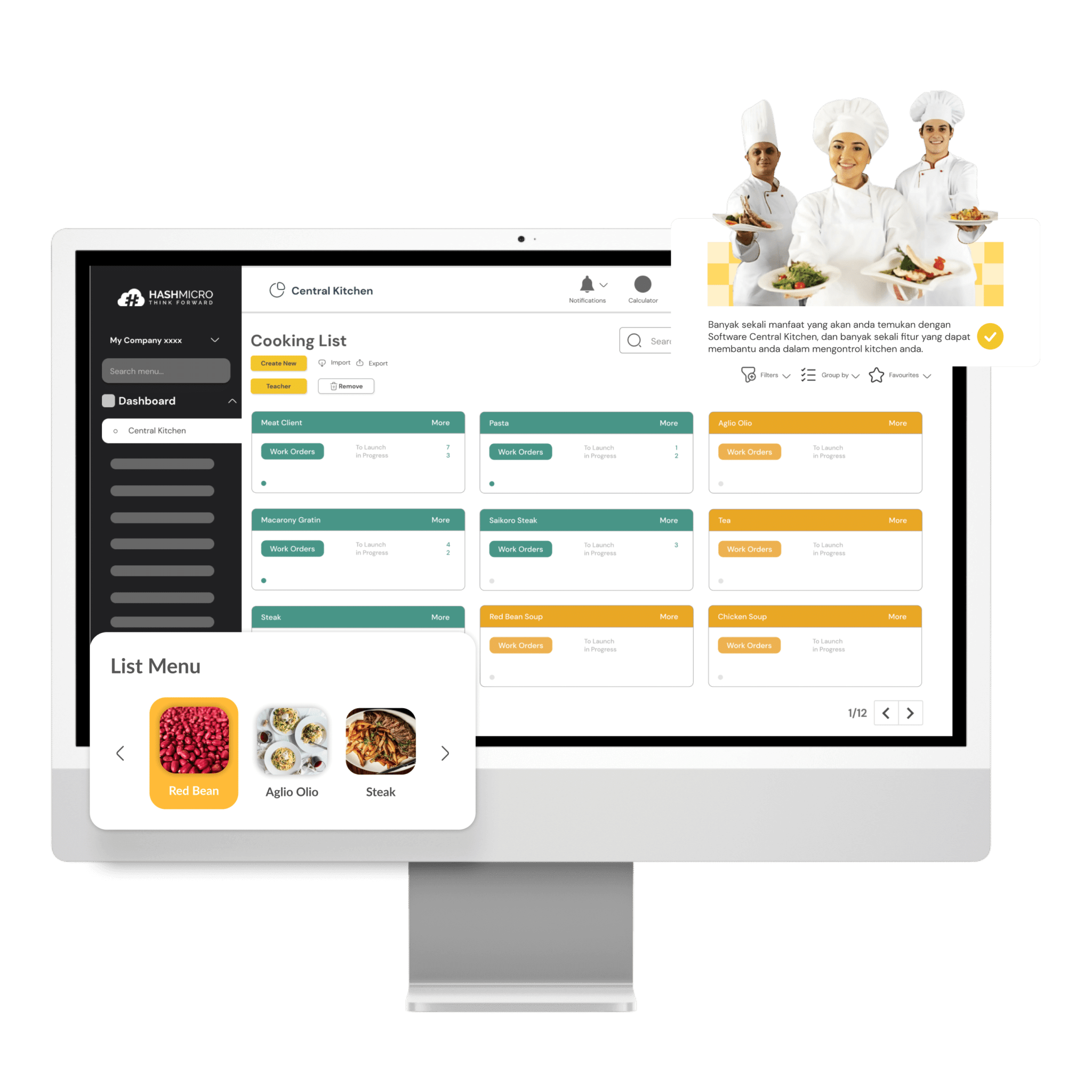
HashMicro is a robust and comprehensive solution trusted by over 2,000 world-class enterprises such as McDonald’s and Banban. It offers various modules and software solutions that cater to different business needs.
HashMicro’s Central Kitchen Software is designed to be user-friendly, making it easy for individuals with limited technical expertise to navigate. Its customizable features and seamless integration with existing systems make it an ideal solution for businesses in the Philippines looking to enhance their central kitchen operations.
HashMicro also offers a free demo so you, the prospecting client, can explore the features and modules available firsthand without having to commit.
Here’s how HashMicro’s Central Kitchen Software can benefit companies in the Philippines through its key features:
- Ordering portal: This portal streamlines customer ordering, ensuring seamless transactions, enhanced satisfaction for Philippine businesses, and efficient order processing.
- Suppliers management: The software monitors supplier contracts and inventory costs, assisting businesses in choosing optimal deals, which is crucial for cost control in the Philippines’ competitive landscape market.
- Kitchen screen: Kitchen screens provide real-time updates for chefs, ensuring efficient food prep management, which is essential for prompt service in the Philippines’ bustling central kitchens.
- Delivery management: Efficient ingredient shipment tracking ensures quick delivery management, which is crucial for business success in the Philippines’ expansive market.
- Inventory management: The system auto-tracks stock, quality, and expiry, alerting on low inventory to help Philippine firms avoid shortages, minimize waste, and optimize costs.
- Central kitchen reports: The system’s reporting on kitchen operations, sales, and logistics, complete with analytics, empowers Philippine businesses to make informed decisions, which is crucial for staying competitive in the food service sector.
| Pros | Cons |
| ✓ User-friendly interface, easy to navigate
✓ Highly customizable, ✓ Seamless integration ✓ Unlimited users ✓ After-sales service and maintenance |
× Timelines for implementation differ for businesses with complex operational needs |
2. Xenia
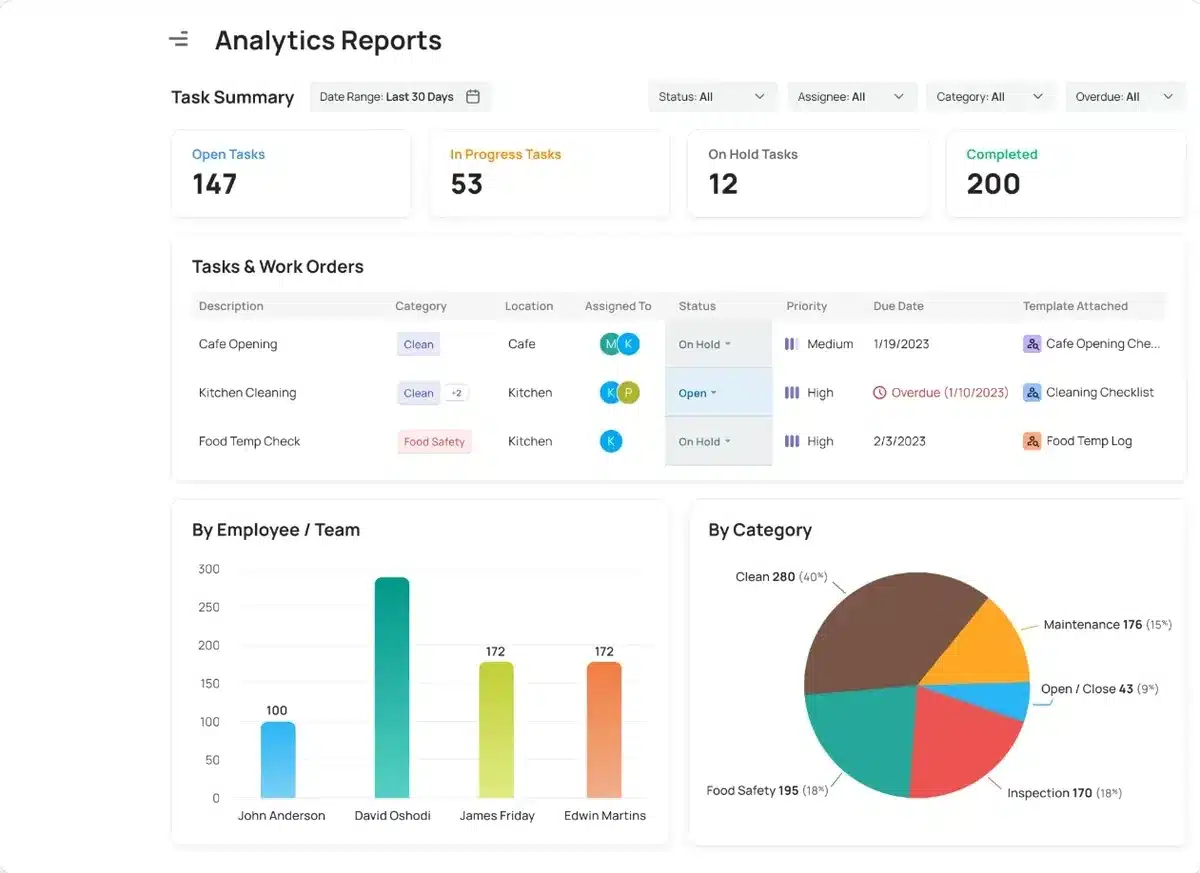
Xenia is a comprehensive digital platform designed to optimise operations in commercial kitchens, particularly for multi-unit restaurant chains. It integrates various aspects of kitchen management, including task delegation, inventory control, compliance monitoring, and team communication
Key Features of Xenia:
- Task Management: The platform supports scheduling, reminders, and real-time task tracking to ensure accountability and timely completion.
- Inventory Management: Tracks ingredient levels across multiple locations in real-time.
- Digital Checklists and Forms: This system replaces manual checklists with digital forms for tasks like equipment checks and hygiene inspections.
- Multi-location Oversight: Centralized monitoring to ensure uniformity in operations.
- Analytics and Reporting: Delivers real-time data on performance metrics.
| Pros | Cons |
| ✓ Simplifies user experience for quick adoption and efficient operation
✓ Comprehensive compliance tools ✓ Real-time data access |
× uses a subscription model that may concern small businesses
× Integration requires lenghty training and system customization processes. |
3. Apicbase Central Kitchen
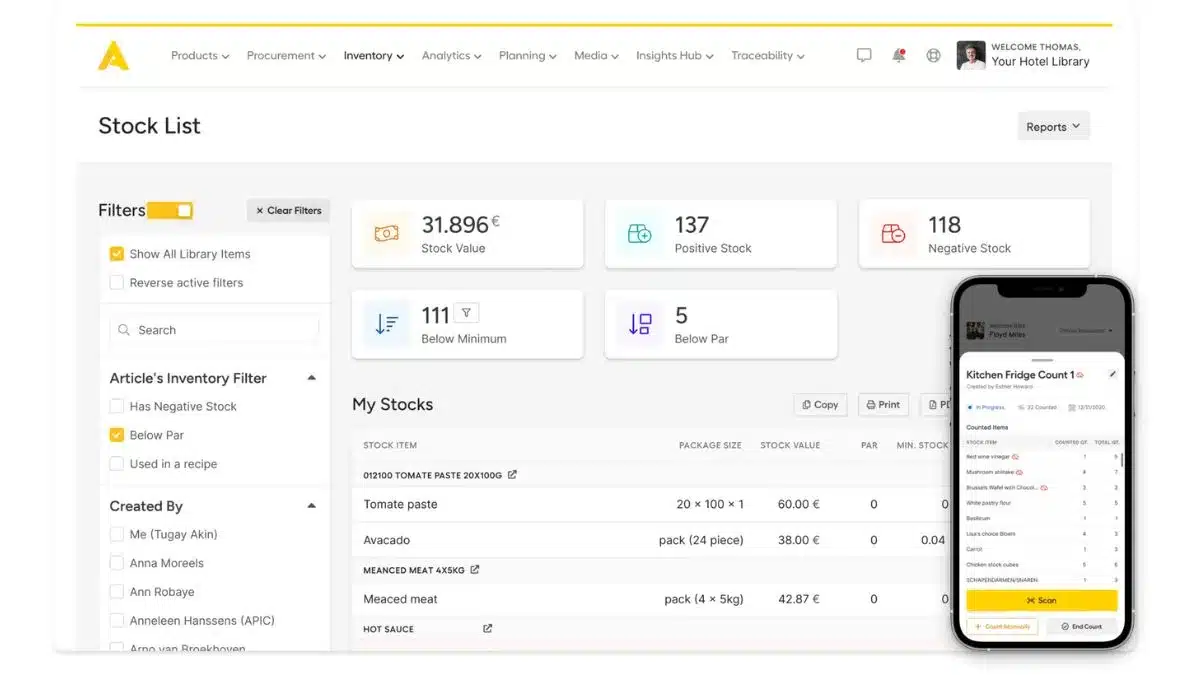
Apicbase is a central kitchen software that provides a comprehensive solution for inventory management, menu planning, and ingredient distribution in the F&B industry. Specifically designed to meet the needs of centralized kitchen operations, Apicbase allows businesses to monitor ingredient levels in real-time and ensures consistent product quality across all branches.
This software is ideal for large restaurants, cloud kitchens, and catering companies that require an efficient, centralized kitchen management system.
Here are the core features:
- Menu engineering: A central hub for managing recipes, menus, and data group-wide.
- Production planning: Tools for planning production, generating Bills of Materials (BOMs), and monitoring execution.
- Inventory management: Capabilities to prevent waste and shortages and monitor stock levels at every location.
- Sales analytics: Analytics to identify top-performing and underperforming products, helping to develop profitable and popular items.
| Pros | Cons |
| ✓ Suitable for both small and large multi-site operations
✓ User-friendly interface ✓ Efficient integrations |
× Limited customization
× Potentially high cost for integration × No trial or demo offers available. |
4. GoFrugal Kitchen Management

Gofrugal is a management system designed to enhance the efficiency and profitability of central kitchen management system operations. It manages production planning, stock transfers, franchise management, waste reduction, and vendor collaboration.
Here are the main features:
- Franchise management: Ensure brand taste consistency across franchises with unified recipes.
- Menu engineering: Examine sales and trends to refine menus and identify savings.
- Vendor management: Centralize vendor data, streamline procurement, and monitor performance for supplier management.
- Wastage management: Minimize waste and maximize profits by tracking recipe ingredient utilization and shelf life.
- Integrated accounts module: Simplify audits with an accounts module that ensures restaurant price consistency.
| Pros | Cons |
| ✓ Comprehensive solution for production, inventory, and franchise management
✓ Auto-indent and integrated accounting |
× Integrating Gofrugal with other systems or apps may incur extra costs and complexity
× Less intuitive UI, needing extra staff training |
5. Supy Central Kitchen Software
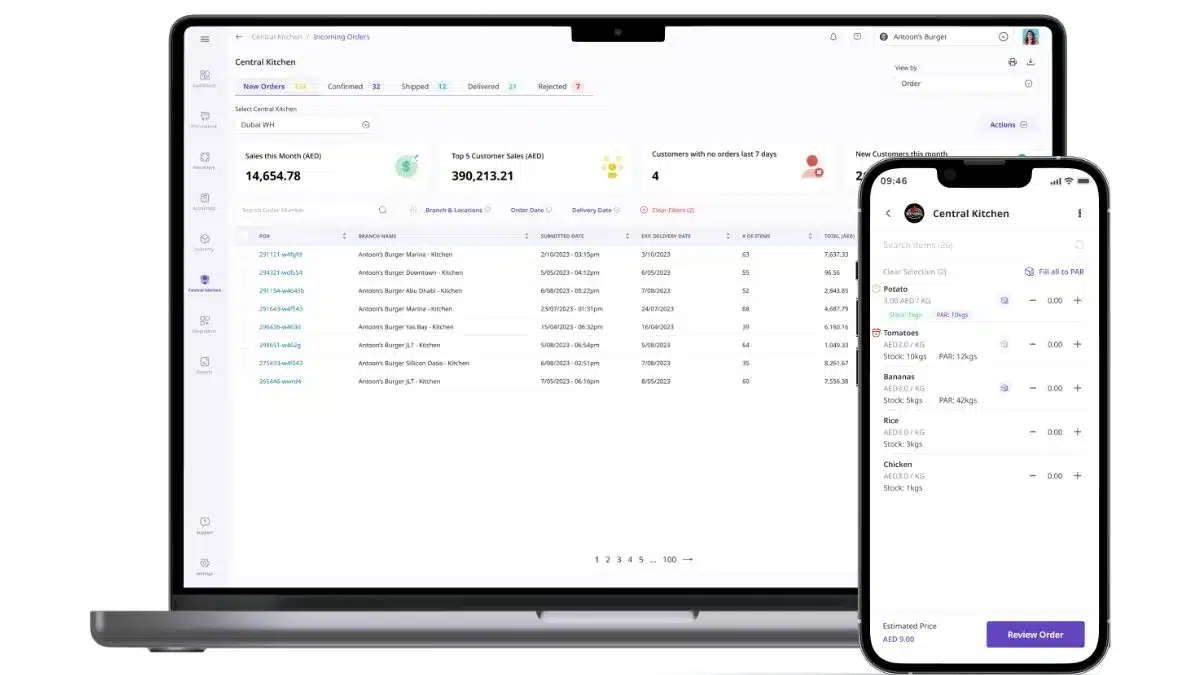
Supy is designed to streamline operations for food and beverage businesses by enabling internal ordering and transfers between branches and the central kitchen.
This kitchen order management system focuses on improving the internal supply chain operation, making it easier for businesses to manage their central kitchen’s production and distribution processes effectively.
The key features of Supy’s central kitchen software are:
- Internal ordering: Enables branches to place orders with the central kitchen.
- Batch productions and transfers: Allows for mass production and bulk shipping.
- Dedicated central kitchen module: Offers a specialized module for central kitchen operations.
- Clear order statuses: Provides real-time updates on order statuses.
| Pros | Cons |
| ✓ Allows any branch to be configured as a central kitchen
✓ Enables efficient internal ordering across branches ✓ Provides real-time updates on order statuses |
× High subscription fees for premium features
× Designed for internal supply chain operations, limiting its appeal to businesses wanting wider features × Limitations in offline use |
6. Melba Central Kitchen Management System
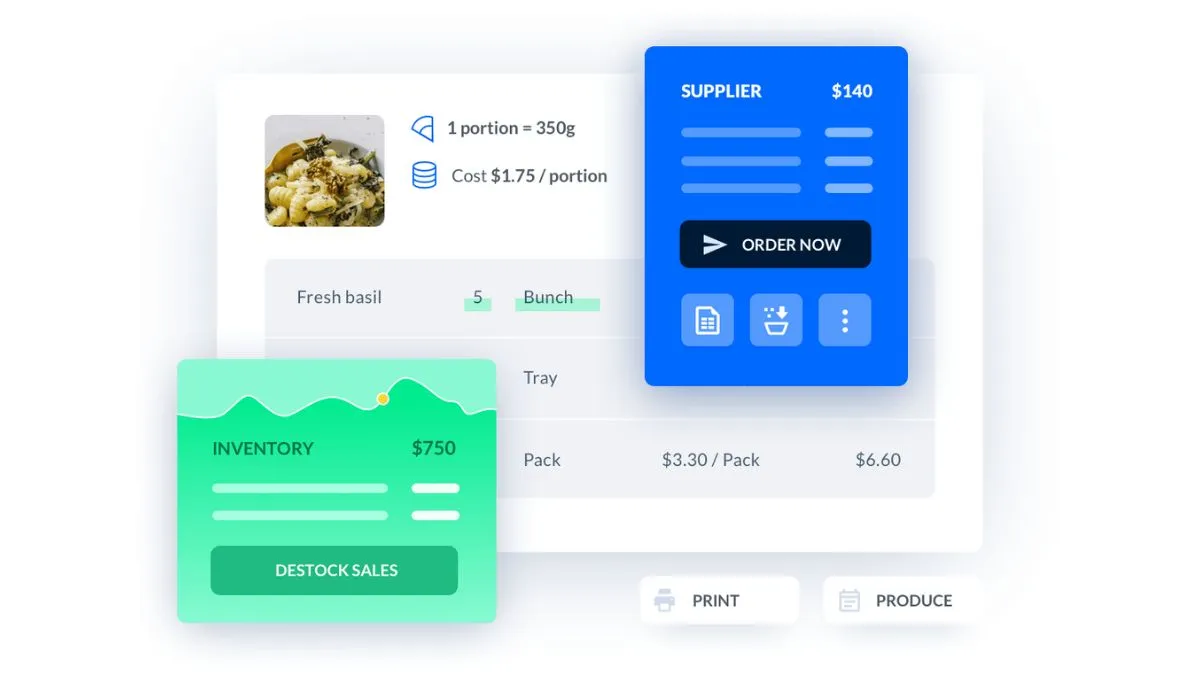
Software Melba is a management tool designed to optimize the operations of central kitchens, which are the hubs of food production for various dining establishments. Melba streamlines processes such as ingredient and recipe management, production scheduling, and order organization.
This central kitchen software allows for centralized control over food production, helping to save time, reduce waste, and boost profit margins.
Here are the main features of Melba:
- Ingredient and recipe management: Create and manage ingredient and recipe databases to ensure uniform quality and standards across all outlets.
- Dynamic recipe data: Work with dynamic data that can be synchronized with multiple sales points.
- Production for multiple sales sites: Organize production by merging identical needs and dispatching finished products to various points of sale.
- Operational management: Optimize operations for supply to various sales sites.
- Inventory optimization: Manage stocks of ingredients, recipes, and drinks efficiently, and conduct inventory with precision.
- Supplier order placement: Place orders with suppliers directly through the software.
| Pros | Cons |
| ✓ Streamlines order management, inventory, and production, enhancing operations efficiency
✓ Optimized efficiency ✓ Aids in managing several central kitchens across various locations |
× May lack extensive customization options
× Integrating with other systems may incur additional costs × Less intuitive interface, resulting in a steep learning curve × Limited to businesses with large production scales |
7. Restroworks Central Kitchen Management Software
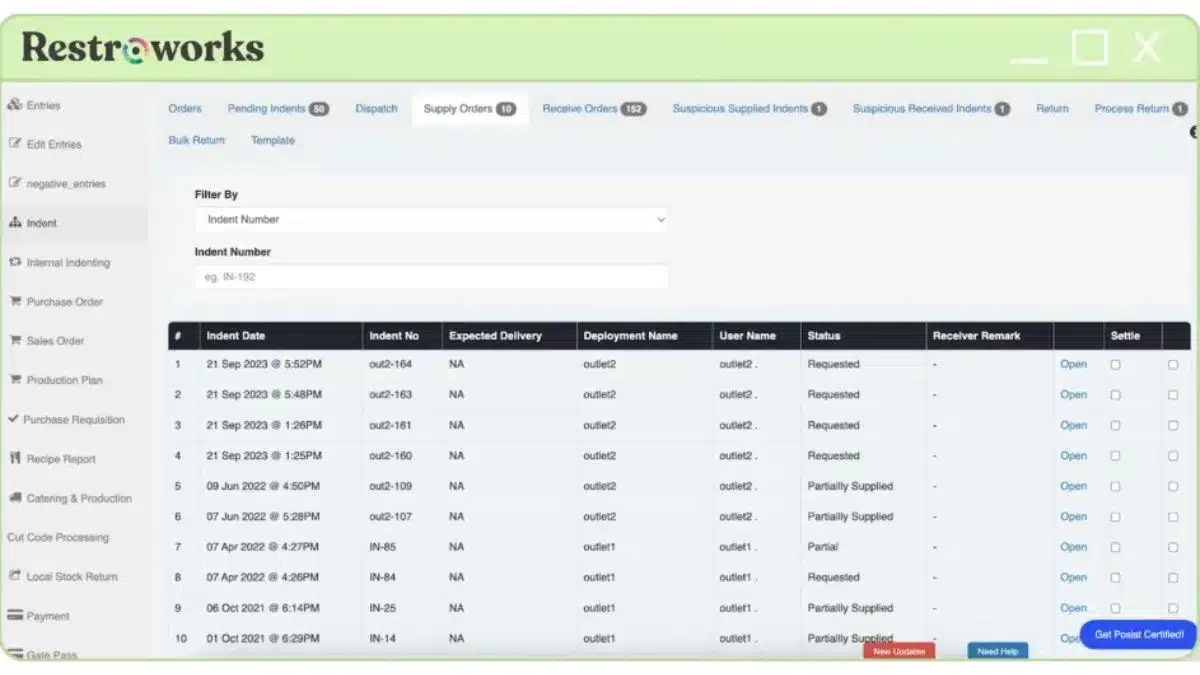
Restroworks is designed to optimize the operations of a central kitchen, the core facility that prepares and supplies food to various dining locations. This software ensures efficient goods transfer, cost control, and optimized inventory for a restaurant’s central kitchen and outlets.
Here are the key features of Retroworks:
- Inventory management: Streamline inventory to reduce waste and boost profitability.
- Recipe management: Accurate tracking of kitchen ingredients for waste reduction.
- Base kitchen: Centralize kitchen software to optimize operations.
- Kitchen display system: Organize kitchen chaos with a display system.
- Kitchen production system: A future-ready system to enhance kitchen productivity.
| Pros | Cons |
| ✓ Comprehensive management
✓ Real-time insights ✓ Caters to diverse restaurant types |
× Integrating Restroworks may incur extra modification costs
× Restroworks’ Interface may slow adoption and training needs × Initial investment is quite large for full features |
8. LS Retail
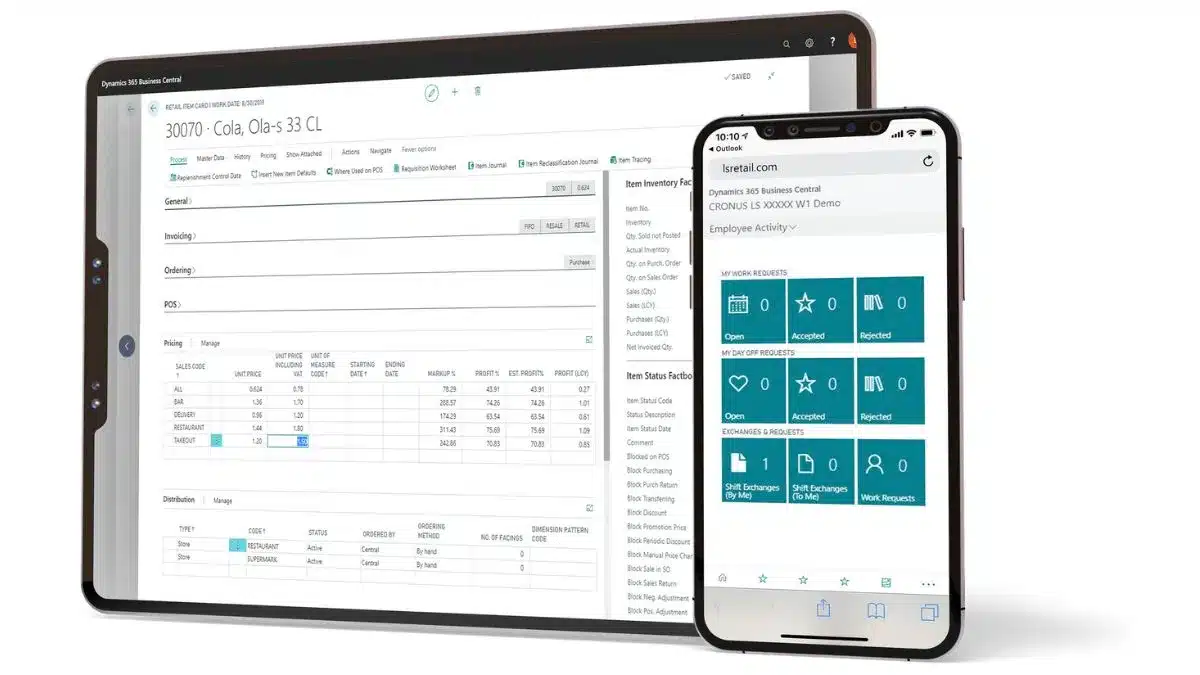
The LS central kitchen software is a comprehensive solution designed to optimize the operations of a central kitchen, which is the hub of food preparation and distribution for restaurants, cafes, and other food service establishments.
It’s part of the LS Retail suite of products and is specifically tailored to improve efficiency and communication between the front house (where customers are served) and the back house (where food is prepared).
Here are some key features of the LS Retail’s central kitchen software:
- Kitchen Display System (KDS): Streamlines order organization and recipe management and ensures correct display sequencing at kitchen stations.
- Efficient workflow: Enhances workflow, links house areas, and aids in consistent dish preparation per guest specs.
- Order management: A KDS allows kitchen staff to prioritize food prep over ticket management, enhancing customer service with faster, precise order processing.
- Digital order viewing screens: They eliminate printers and paper, directing POS orders straight to the proper prep stations.
| Pros | Cons |
| ✓ Integrated solution
✓ Allows for extensive customization to meet specific needs ✓ Can scale with the business |
× Implementing custom features may take more time and expertise
× Setup can be complex, and unfamiliar staff may face a steep learning curve × Challenges may arise when integrating with external systems |
9. Galley Central Kitchen
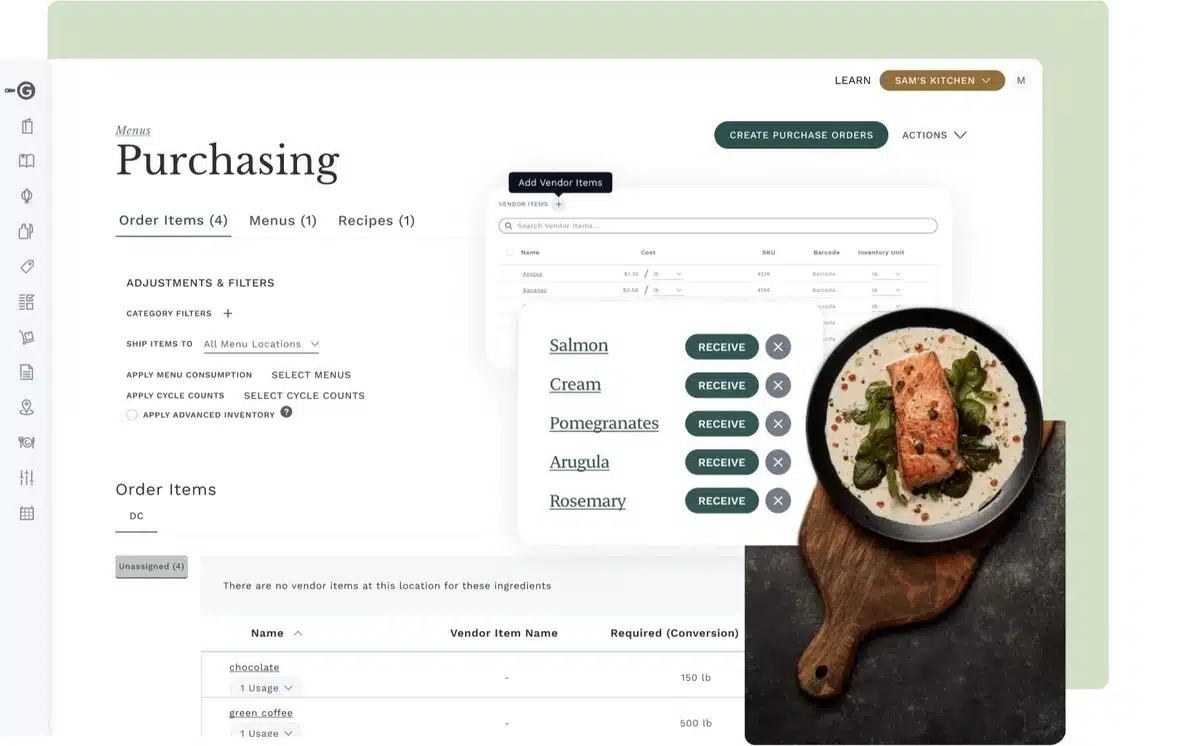
Galley Solutions is a central kitchen system designed to help F&B businesses optimize kitchen operations through efficient recipe management, inventory, and production planning. With Galley, businesses can improve product quality consistency and reduce raw material waste.
Galley Solutions is suitable for: non-commercial food service operations, delivery-native businesses, and operators with multiple units, including mid- to large-scale restaurants, cafes, and catering businesses.
Here are some key features of the Galley’s central kitchen software:
- Recipe management with automatic scaling
- Cloud-based real-time inventory tracking
- Integrated production and purchasing planning
- Ingredient and menu cost analysis
- Integration with POS and ERP systems
| Pros | Cons |
| ✓ Minimizes waste through proper planning
✓ Intuitive and easy-to-use user interface ✓ Responsive and professional technical support |
× Initial investment is quite high for small scale
× Not all features are available in the basic package × Complex integration with some legacy systems |
10. LINGA ROS Kitchen Management System
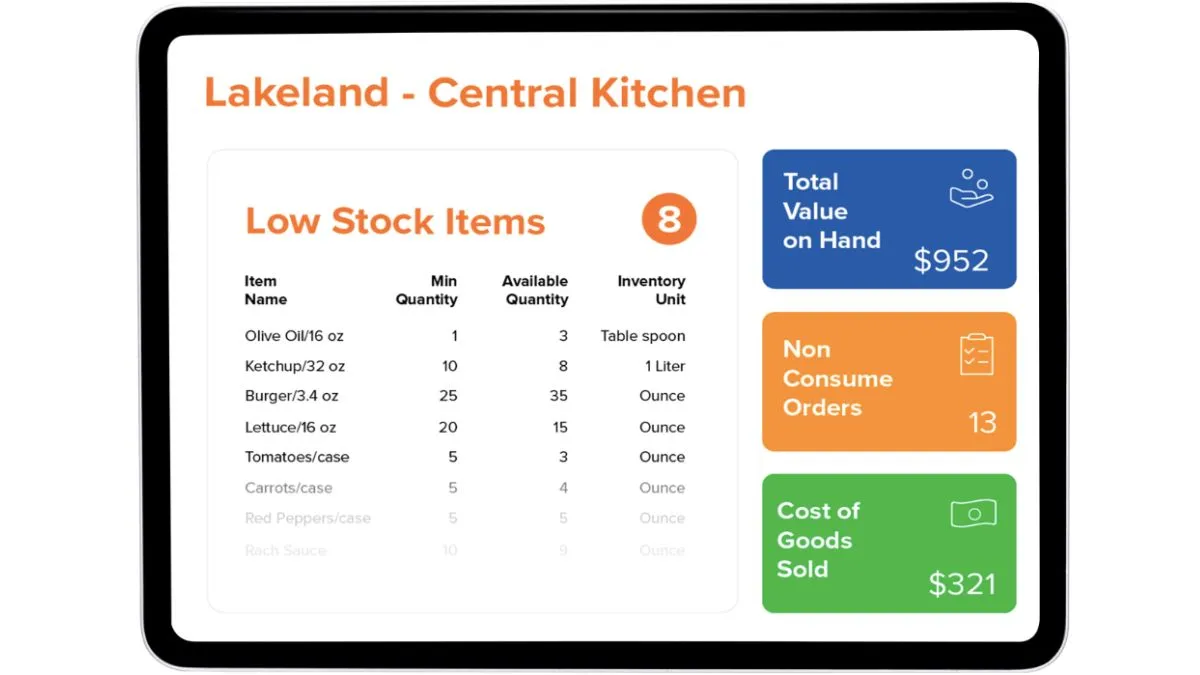
LINGA ROS, which stands for Restaurant Operating System, is a comprehensive point-of-sale (POS) system designed for the restaurant and retail industry.
It’s a cloud-based platform that offers a suite of applications to manage various business aspects, including central kitchen operations.
Here are the key features of LINGA ROS Kitchen Management System :
- Cloud-based system: Ensure that updates and upgrades are automatic and that the system can adapt to the business’s changing needs.
- Inventory management: It offers real-time tracking of inventory levels, sets reorder points, and receives live inventory shipment updates.
- Quality control: The software maintains high standards of food quality and safety.
- Order management: Streamlines the process of managing orders from different outlets.
| Pros | Cons |
| ✓ Offers a high degree of customization and flexibility
✓ The system is known for its user-friendly interface ✓ strong integration capabilities |
× Customer support often falls short of expectations
× Complex integration with some legacy systems × Its features may not justify the cost compared to alternatives. |
How to Choose the Right Central Kitchen Management System for Your Business
Selecting the ideal central kitchen management system for your food and beverage business involves carefully assessing key factors to ensure it aligns with your needs. Here’s what to look for:
- Key Features: The software should offer essential capabilities such as inventory management, recipe standardization, production scheduling, procurement, real-time reporting, and a kitchen display system to organize orders and optimize prep times.
- Reputation of the Software: Assess the software’s reputation by reviewing customer feedback, case studies, and industry certifications. Additionally, ensure the software provider offers reliable customer support and regularly updates the system.
- Scalability and Integration: Choose software that can grow with your business and integrate well with existing systems, such as a cloud POS system, CRM, and supply chain tools, for seamless communication and centralized data management.
- Ease of Use: Choose software with a straightforward and intuitive interface, which reduces training time and enhances staff efficiency.
Customization and Flexibility: Make sure the software can be tailored to meet your business’s unique requirements, offering customizable features and flexible pricing options to help manage costs. - Security and Compliance: Prioritize software with strong data protection protocols, adhering to data privacy regulations and using encryption to secure sensitive information.
By considering these factors, F&B businesses can choose a central kitchen system that enhances operational efficiency, supports growth, and adapts to changing needs. Selecting the right software can greatly improve your operations and contribute to long-term success.
Conclusion
A central kitchen is critical in ensuring food quality and customer service. To achieve this, it is essential to ensure that all kitchen operations run efficiently and effectively. Central kitchen software represents a viable solution to simplify, accelerate, and optimize central kitchen operations while mitigating kitchen risks.
Considering the criteria discussed, HashMicro’s Central Kitchen Software stands out as a top contender. It’s user-friendly, scalable, and customizable to cater to your business’s unique demands. Plus, your business data is in safe hands with robust security measures.
Don’t just take our word for it; experience the difference firsthand. We invite you to try a free demo today at no cost. See for yourself how it can transform your operations and help you stay ahead in the competitive F&B landscape.
FAQ About Central Kitchen Software
-
How does central kitchen software help reduce food waste?
The software tracks inventory in real time, alerts for expired items, and ensures efficient production planning. It reduces unnecessary waste and helps businesses produce just the right amount of food.
-
Can small businesses use central kitchen software?
Yes, central kitchen software is scalable and customizable, making it suitable for large and small businesses. It streamlines operations and improves inventory accuracy, regardless of business size.
-
How does central kitchen software improve customer satisfaction?
Central kitchen software helps businesses deliver a better and more reliable customer experience by ensuring consistent food quality, reducing errors, and speeding up order processing.





































